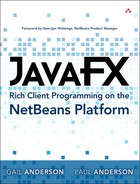Preface
The NetBeans Platform provides a rich client framework to build desktop applications in Java and JavaFX. Its design has a certain symmetry and elegance. As you use its many APIs, each new feature learned will become familiar. You’ll learn that this familiarity, coupled with code and design reuse, is a good trait.
Simply stated, the NetBeans Platform will save you years in building and maintaining application framework code. Even the simplest NetBeans Platform application has amazing features. And the platform’s best feature is that as users change and technology and requirements evolve, your application can evolve, too.
Our Approach
This book takes a holistic approach to presenting the NetBeans Platform. We begin with the basic Java architectural tenets of event notification, JavaBeans property support, and UI responsiveness with background tasks. As we build upon these Java basics, we present the NetBeans Platform APIs and features in the context of small sample applications. For example, you will learn how the Nodes API, Action framework, Lookup API, and modular architecture all contribute to the overall design of a CRUD-based database application. Our examples are relatively small and familiar, so you can spend more time learning the NetBeans Platform APIs and not our application business logic.
We wanted to write a book that pulls together many of the excellent NetBeans Platform tutorials and documentation so that you don’t have to search for examples. To that end, we provide you with a lot of sample code including screen shots and step-by-step instructions to help you on your journey.
And finally, this book is not just about the NetBeans Platform. With this text, we want to encourage Swing programmers out there to take the plunge with JavaFX. If you want to leverage the ease and beauty of JavaFX, the NetBeans Platform can help you transition from a Swing UI to a JavaFX UI as you develop applications. In fact, the modular architecture of the NetBeans Platform is a great vehicle for easing into JavaFX. Pinpoint your requirements that fit well with JavaFX and start there. Do your visualization requirements include charts or perhaps 3D? Maybe you’d simply like to have stunning effects, such as linear gradients, drop shadows, or animations. Pick and choose all you want, but know that you’ll still have the underpinnings of a modular, well-designed NetBeans Platform application.
About the Examples
You can download the source for the reference application (described briefly in “FamilyTreeApp Reference Application” on page 10) at https://java.net/projects/nbfamilytreeapp. You can download the remaining examples and projects described in this book at http://www.asgteach.com/NetBeansPlatformBook/.
Notational Conventions
We’ve applied a rather light hand with font conventions in an attempt to keep the page uncluttered. Here are the conventions we follow.

Acknowledgments
First, we’d like to thank Geertjan Wielenga, without whose involvement, this book would not have been written. Geertjan provided both technical and philosophical support and introduced us to the vast NetBeans Community.
We’d also like to thank our readers. John Kimball provided much valuable feedback that especially shaped our early chapters. Both Mike Kelly and Stephen Voynar participated in reading early versions of the chapters.
Greg Doench, our editor at Pearson Technology Group, is a good friend and was a valuable part of this project. In fact, Greg has guided us through many book projects. Thank you as well to Elizabeth Ryan at Addison-Wesley, who oversaw the book’s production. Her attention to detail and keen eye kept the project on track with a fast-paced production schedule. Our copy editor, Geneil Breeze, performed an amazing feat in making our manuscript as consistent as possible.
The NetBeans Platform has always had a strong, active community of software developers and technical writers. We’d especially like to thank the many members of the NetBeans Community who influenced and helped us in our NetBeans Platform journey, mostly without realizing it. Certain names appear over and over, contributing technical solutions to a myriad of questions asked by the community at large. We’d like to thank and recognize Jaroslav Tulach, Geertjan Wielenga, Toni Epple, Sven Reimers, Tim Boudreau, Tom Wheeler, Jesse Glick, Timon Veenstra, Sean Phillips, and many others who have contributed to the NetBeans Platform body of knowledge.
We’d like to give a shout out to Sharat Chander, who has given us opportunities to meet and mingle with Java experts at home and internationally.
In the JavaFX world, we’d like to thank those who are constantly sharing their knowledge to further the acceptance of JavaFX. Stephen Chin, Jonathan Giles, Richard Bair, Brian Goetz, Jim Weaver, Gerrit Grunwald, and Carl Dea have all contributed to our understanding of the finer points of JavaFX. And finally, we’d like to thank Adam Bien, who has been a strong advocate and an early adopter of JavaFX for real-world applications.
Gail and Paul Anderson
Anderson Software Group, Inc.www.asgteach.com
